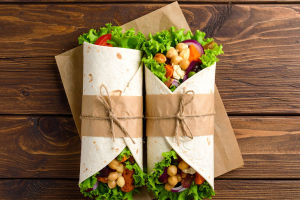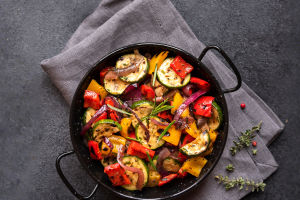High-Protein Veg Meals

Is it really possible to get enough protein on a vegetarian diet without relying on meat or animal products? Many people wonder if going plant-based means sacrificing strength, energy, or muscle gains.
The answer is: not at all. If you choose the right ingredients and plan your meals smartly, you can absolutely meet your protein needs—sometimes even better than meat-eaters.
Today, let's break down how high-protein vegetarian meals work and go deep into a few practical, nutrient-dense options you can try at home.
Why Protein Matters, Even for Vegetarians
Protein is essential for muscle repair, hormone production, and keeping you full and energized. While meat is often seen as the easiest source of protein, many plant-based foods are rich in it too—and they come with added benefits like fiber, vitamins, and antioxidants.
The key is knowing how to combine plant-based protein sources efficiently and deliciously.
1. Lentil and Quinoa Power Bowl
Protein source: Lentils and quinoa
Approximate protein: 18–22 grams per serving
This warm bowl is not only hearty and satisfying but also packs a serious nutritional punch.
How to Make:
• Cook ½ cup of dry green or brown lentils until tender.
• Simultaneously, cook ½ cup of quinoa (which contains all 9 essential amino acids).
• Roast a mix of vegetables like carrots, zucchini, and red peppers with olive oil and paprika.
• Toss everything together with a tahini-lemon dressing and top with sunflower seeds for a nutty crunch.
This dish balances protein, fiber, and healthy fats while keeping you full for hours.
2. Chickpea Pasta with Pesto
Protein source: Chickpea-based pasta
Approximate protein: 20–25 grams per serving
Chickpea pasta is a game-changer. Unlike traditional wheat pasta, it's naturally high in protein and gluten-free.
How to Make:
• Cook chickpea pasta according to package instructions.
• In a blender, mix fresh basil, walnuts (or sunflower seeds), garlic, lemon juice, olive oil, and a spoonful of nutritional yeast for a cheesy, dairy-free pesto.
• Toss the pasta with the pesto and top with cherry tomatoes and steamed spinach.
Fast, flavorful, and packed with plant-based fuel.
3. Greek Yogurt and Chia Seed Breakfast Parfait
Protein source: Greek yogurt and chia seeds
Approximate protein: 20 grams per cup
This makes a protein-rich breakfast or snack that also supports digestion and satiety.
How to Make:
• In a jar or glass, layer plain Greek yogurt, a tablespoon of chia seeds, berries, and a handful of rolled oats.
• Let sit overnight or for at least 2 hours if you prefer a thicker consistency.
• Add a drizzle of honey or maple syrup if you like it sweet.
It's quick to prepare and customizable depending on your fruit of choice.
4. Edamame and Soybean curd Stir-Fry
Protein source: Soybean curd and edamame
Approximate protein: 25–28 grams per serving
Soybean curd has been a plant-based staple for centuries, and edamame (young soybeans) adds even more protein to this dish.
How to Make:
• Press and cube a block of firm Soybean curd, then pan-fry until golden.
• Add a cup of shelled edamame, broccoli, and bell peppers to the pan.
• Stir in a sauce made from soy sauce, sesame oil, garlic, and a touch of maple syrup.
• Serve over brown rice or soba noodles for extra fiber.
This is one of the best high-protein dinners that feels just like takeout—minus the heaviness.
5. Seitan and Mushroom Tacos
Protein source: Seitan
Approximate protein: 30+ grams per serving
Seitan, made from wheat gluten, is one of the most concentrated plant protein sources and has a meaty texture that works well in tacos.
How to Make:
• Slice seitan and sauté with onions, mushrooms, smoked paprika, and a dash of lime juice.
• Load it into warm corn tortillas.
• Top with avocado slices, shredded cabbage, and a dairy-free yogurt drizzle.
It's indulgent, high-protein, and perfect for a satisfying meatless dinner.
Dr. Walter Willett, nutrition researcher at Harvard T.H. Chan School of Public Health, has stated that a well-planned vegetarian diet can provide adequate protein and support long-term health.

Tips for Building a Protein-Rich Vegetarian Plate
You don't need to overcomplicate it—just keep these principles in mind:
1. Mix your sources – Combining legumes, whole grains, seeds, and dairy (if not vegan) gives you a complete amino acid profile.
2. Add nuts and seeds – A tablespoon of flaxseed, chia, or flax can sneak in 3–5g of protein.
3. Don't forget dairy or alternatives – Greek yogurt, cottage cheese, or fortified plant milks add easy protein.
4. Track your intake – Apps like Cronometer can help ensure you're getting enough protein daily (about 0.8g per kg body weight, or more if you're active).
Final Thought: Can You Thrive Without Meat?
Absolutely. Whether you're a full-time vegetarian or just trying to cut back on meat, these high-protein meals prove that you can feel energized, stay strong, and enjoy delicious food every day. It's not just about avoiding animal products—it's about choosing meals that work harder for your body.
Do you already have a favorite high-protein vegetarian meal? Or are you planning to try one of these? Let me know what's going on your plate next!


